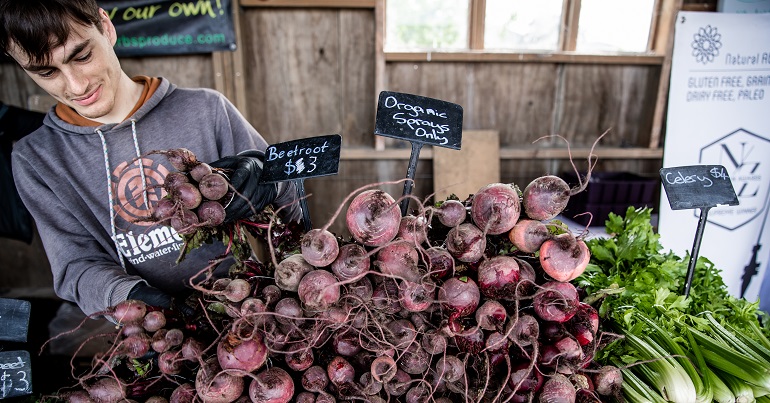Primary industries (featuring horticulture)
Tāmaki Makaurau has a small proportion of its land dedicated to horticulture production (2%), which contributes 25% of its vegetable production.
On this page
Tāmaki Makaurau has large areas of farmland, especially in the south (Franklin) and far north (Rodney) local board areas and includes large-scale horticulture production in the north and west. The region also has pine forests and employs people in fishing and aquaculture.
Matching farm production data to land use capability for Auckland(external link) — Knowledgeauckland.org.nz
Muka Tangata
Muka Tangata (People, Food and Fibre) Workforce Development Council represents the Food and Fibre sector and is working on ways to enhance vocational education and training to meet industry needs. The Group RSLG has been working with Muka Tangata to better co-ordinate workforce-related challenges for the primary hospitality sector in Tāmaki Makaurau.
In 2021, the Muka Tangata Workforce Development Council workforce was 20,207 filled jobs with a contribution of $1,593 million to GDP. Landscape gardening is the largest sector occupation in the region (6%). There are 9.5% Māori employees (Infometrics 2022).
COVID-19 has limited access to the Recognised Seasonal Employer workforce which has a large role in horticulture management and harvesting. Tāmaki Makaurau is the fourth largest horticultural producing region in Aotearoa New Zealand and has the country's largest concentration of indoor crops, including capsicum, cucumber, and tomatoes. The Pukekohe growing hub is vital, and good access to transport makes Tāmaki Makaurau's horticultural sector a critical strategic economic asset to Tāmaki Makaurau and Aotearoa New Zealand's food supply and security.
Agenda of Franklin Local Board – Tuesday, June 22, 2021(external link) — Auckland Council
A technology shift is occurring in farming and horticultural practices with new technologies, platforms and robotics to develop, grow, manage and harvest crops. A new generation of skills and jobs must embed these technologies in the Horticulture sector. The Franklin Skills Hub is taking action to increase agritech skills (Auckland Unlimited, 2022. Franklin Local Board Skills Report – Matching Farm Production Data to Land Use Capability). As highlighted in the Agritech Industry Transformation Plan, these challenges also bring opportunities due to COVID-19 which has increased the demand for agritech products. For example, restrictions on the movement of migrant workers are deepening labour shortages in the Horticulture sector and increasing demand for automation solutions .
Recognised Seasonal Employer (RSE) scheme research(external link) — Immigration New Zealand
Agritech industry transformation plan [PDF, 3 MB]
Horticulture labour market and workforce insights
- The 2 largest occupations - Horticulture Nursery Assistants and Market Gardeners - combined represent less than 1% of the total Tāmaki Makaurau workforce.
- The Horticulture and Fruit Growing sector employed 3,562 people in Tāmaki Makaurau in 2021. This is 0.4% of the total workforce and is forecast to grow by 276 jobs in the next 5 years.
Workforce planning challenges
- There is higher reliance on migrant labour than the rest of Aotearoa New Zealand – 38.4% versus 15.8% for this sector. Due to the seasonal nature of work, there are challenges in hiring domestic labour. The sector also has limited career progression due to flat organisational structures.
- The Horticulture sector in Tāmaki Makaurau has a demand for entry-level roles. Still, it is also increasing demand for innovation, science and technology skills to meet the demand for genetics and cultivars innovation, robotics and automation in agritech-related farming. Innovation requires new skills, and the Horticulture sector is increasingly short of new skills to adopt innovations and technologies to improve growth and productivity.
Regional Skills Outlook(external link) — Infometrics
Horticulture sector actions
- The RSLG will support and plan with local employers, local boards (Franklin and Rodney) and the Franklin Skills Hub to improve the sector's attractiveness for workers with a focus on pastoral care and improvement of industry practices.
- The RSLG promotes working with Māori and Muka Tangata to support Māori in mahi and shares the Muka Tangata vision of the wider system, one where vocational education adapts and responds to ākonga and industry needs, with a critical focus on Māori.
- The RSLG promotes regional partnerships with Waikato, Bay of Plenty and Tai Tokerau Regional Skills Leadership Groups due to the proximity of the major sector employers in Rodney and Franklin local board areas.
- The RSLG will work with Muka Tangata (People, Food and Fibre) Workforce Development Council to look at the workforce skills needed to support innovation and technology in the sector.
- The RSLG will work with the Agritech Industry Transformation Plan to identify opportunities to engage with the Muka Tangata Workforce Development Council, and to discuss potential involvement in delivering relevant actions and ensuring agritech skills needs and priorities for the region.
Mukatangata website(external link)
276 new jobs in the next 5 years
3,562 filled jobs in horticulture

Auckland Unlimited.

